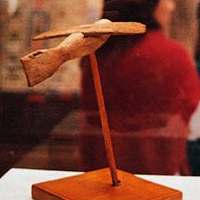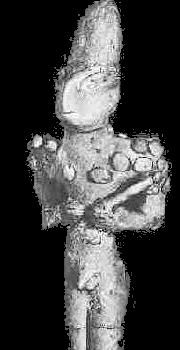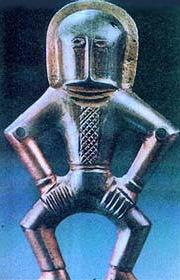 |
Chariots
of the
Gods
Spacesuits
Flying Saucers
Flaming Shields
Delta Wing Jets
and Ray Guns
depicted on
everything from cave walls
to ancient Egyptian temples
all surviving eyewitness accounts of
UFO sightings in our most ancient past
For modern eyes
just looking at
the most ancient
cave drawings
and petraglyphs
it seems impossible to
take them for anything
other than technology.
In historical times,
demons and elves
ruled darkest nights
even in the Bible,
angels and devils
ascend to the clouds.
Could travelers from outer space
have visited this planet long ago?
Could our ancestors
have settled this planet
as space colonists?
Will our neighbors
reveal themselves,
when we are ready?
|
|
|
 |
 |
Von Daniken
- caption, translated: "Wooden airplane model in the Egyptian Museum, Cairo.
For many years, this model stood directly behind the main entrance in a glass case.
In the meantime it disappeared in the cellar. Were uncomfortable questions placed?"
|
|
|
|
Carved in Stone
Throughout history, extraterrestrials have been making continual contact with the Humans beings on planet Earth.
- and occasionally, the ancient world speaks to us of strange things that the primitive people of the time attributed to The Gods.
From the Nazca Lines of Peru to ancient aircraft of Egypt and India known as Vimanas;
from the enigmatic and symbolic petraglyphs of Ancient America to the pantheons of European and Mediterranean gods;
nearly every ancient culture, on every continent yet explored - it seems that every civilization in the world was at one time or another touched by beings from above.
|
|
|
|
 |
Ancient Astronaut Cave Art
Val Comonica, Italy
|
|
|
|
As mankind evolves and advances in technology,
we are now becoming somewhat familiar with many of the things that obviously impressed our ancestors enough:
to take time away from hunting and gathering and etch their likenesses in the stone walls that served as the first shelters.
We know that we are not gods, but what would ancient peoples think of most of the things we take for granted today?
Would your ability to read evoke jealousy from their most revered scholars?
Would a disposable lighter or ball point pen get you burned as a witch?
And what would they make of your palm pilot - or for that matter, a harmonica?
The two figures depicted in rock-art at Val Comonica, in Northern Italy (above right)
easily appear to modern observers to be a literal and accurate representation of modern astronauts.
Their bulky suits come complete with space helmets, and each are holding decives of some sort; one of their tools even looking remarkably like a sextant.
This particular site is a perfect example, and is featured in the groundbreaking 1968 book Chariots of the Gods, by Erich Von Daniken
- but is only one of so many found throughout Europe, Asia, Africa and the Americas;
all associating the Gods with the stars, and other things which we modern humans today file under the same heading: space technology.
Could this primitive depiction of a space helmet have been a primitive precursor to what we modern humans know as haloes?
Could all of the world's religions all have a root in these ancient gods who came down from the sky?
For millennia, the absolute authority on the beginning of everything was the Bible
- specifically, the book of Genesis, which tells us the order in which creation began to express itself: first minerals, then plants, then animals.
This is something that the ancient scribes simply could not have known, if we are to remember them as truly primitive
- tribal hunter gatherers, barely farmers - technologically barren, possessing little more than fire and the ability to write stuff down.
Perhaps God emparted this simple itinerary to His chosen scribes, but one of the first things to pop into existence is said to have been Light itself
- which seems to also ring very true, as it turns out, according to modern quantum physics, we're all made of stardust.
The only question remaining is, of course, from which particular star's dust have we been thus assembled?
Modern fundamentalists have retranslated the biblical "light" as, or into, "the word" or "truth" - often meaning "the existence" or "the reality" of God.
This also follows advanced scientific theories that the prime foundation of existence (time, matter, and the very fabric of dimension)
are fractal, and vibrations: made up of infinite combinations of (put very simply) something and nothing - as in binary code, a sequence of ones and zeros.
A parallel can also be drawn from New Age philosophies, which often contend that all is illusion.
For all our fumblings, we have advanced, and perhaps evolved, to the unenviable point where we now know that there is very much that we do not know
- and there is a great deal that we will likely never be able to fathom, but we can still dream and imagine
- and we are at least able to measure our perception of what we perceive to be time and space.
So far, among other things, we have measured the size of the Earth and distance between Earth and the Sun
- very specific values and ratios that are found in multiple archaelogical sites around the world,
where also emanate legends of gods who came down from the sky.
|
|
|
|
|
|
|
Idols
The ancient world is filled with statues, idols and icons - depictions of beings or entities we know or assume were worshiped as gods.
In many cases, it's all we have to go by. Imagine if all that survived of our age was the Statue of Liberty, and a few coins with her face on it.
We would likely be perceived as a race that worshiped Liberty (a strange name), as the Goddess of Fire, or even Goddess of the Sun.
Venus may become jealous.
But In the case of Lady Liberty, the torch and the tablet are obvious enough - but what of the strange points emanating from her head?
What might future archaeologists glean from this amazing find - ceremonial headdress or funky hairstyle?
|
|
|
|
Located just 45 miles outside Mexico City, near Teotihuacan and Tenochtitlan, is Tula
- a megalopolis of the Toltec culture, which is thought to have flourished between 750 and 1250 AD.
Atop a massive platform, with a pyramid base, is the most sacred temple at Tula: Tlahuizcalpantecuhtli, the Temple of the Morning Star.
The big tourist attractions there are several giant statues known as atlantes (above right)
- which are thought to be Toltec warriors, dressed in full regalia, as if standing guard over the city.
Each of them the same height, approximately 15 feet, they are believed to have once supported a roof, that once covered the temple.
Other decoratively carved, slightly shorter pillars are also located on this platform,
and many more are found at the Palace of the Columns, not far away.
|
|
|
|
|
Staggeringly similar in design is "El Ponce" (left) - the idol at Tiahuanaco, near Lake Titicaca in Peru.
It is important to remember that next to nothing is known about the people who founded the site
- but anytime the words "astronomer" and "priest" both appear in the same job title,
chances are that daily routine had less to do with stone carvings and agriculture
than what was really going on in the universe, perhaps just above our protective atmosphere.
The statues of Tula and Tiahuanaco, if made today,
would easily be passed of as works by the same artist (although perhaps from a slightly different period).
They all seem to have been carved from free-standing cylindrical columns, previously erected on the site,
having nothing to do with the culture they're currently associated with.
When one takes in the wider context of the Central and South American sites,
it becomes difficult to not see an immediate connection.
Be it Toltec, Aztec, Inca, Maya, or any other indigenous culture, long since faded into obscurity,
it is believed that these ancient civilizations are remnants of a vast culture which once spread far across the seas
- even to Europe and Asia - and yes, even to Egypt.
Also at Tiahuanaco, jutting out from the walls that enclose the temple
are several dozen stone heads, supposedly depicting the priests of the temple.
This is a common theme in American sites, remarkably similar to the Aztec skulls
- in fact, they have more in common, artistically, with the Mexican ornamentation
than the overall impression one gets when encountering the mega-sites themselves.
It seems as if more primitive cultures had moved in
long after the original architects had abandoned the sites
- and held understandable reverence for whomever it was
that had created such surroundings.
|
|
|
|
|
The Tiahuanaco Heads
Were these heads carved on earlier protuberances of the wall by
people who settled in the abandoned city, and called it their own?
Whether they are the likenesses of their ancestors, elders or priests
perhaps they are also spiritual sentinels, placed there to protect them,
should the gods of the sky wish to return, one day, to reclaim their outpost.
|
|
|
Geographic Geometry
"A New Look at an Old Design" ~ by Jim Alison
Exploring Geographic and Geometric Relationships
Along a Line of Ancient Sites Around the World
|
|
|
Syakou-ki-dogu
"snow goggle-eyed figure"
Jomon Period, 12,000-300 BC
|
|
|
|
|

Malachim
(above right and below)
Sumerian, 3500 BC
|
|
|
|
 |
 |
The Bird Pendant
1st�5th century
Costa Rica
|
|
|
|
 |
 |
 |
 |
Kayapo, the Scythian artifact, 700 BC
found preserved in frozen tombs in the Altai
region of Siberia, Russia - near the China border.
|
|
|
Five figurines of airplanes with serpent heads ~ State Bank of Bogota, Columbia
Replicas are rumored to have once been offered for sale in the gift shop of a local museum
until the stunning but obvious airplane connection was made, when they were quietly withdrawn.
Despite the classic Maya smiling serpent god heads, and the uncanny resemblance to modern airplanes,
some mainstream archaeologists claim the tiny models are of insects, not of delta winged airplanes.
There are said to be many types of such airplane configurations, only five are presented here.
It is however no insect cult well-known with South American Indiovoelkern.
Besides, insects were never represented in gold.
|
|
|
Helmeted Figures
from Equador (above)
The Palenque
Astronaut (right)
and also from Palenque (far right)
where a man seems to be
seated before a console
in both, appears to be
- operating controls -
with hands and feet
Mayan Cualdron (below, right)
resembling a modern jet engine.
|
|
|
|
|
The Palenque Astronaut (above left) appears to depict a man controlling a spaceship.
This ornately decorated five ton stone was discovered in 1952 in Chiapas, Mexico
covering the Tomb of the Mayan King Pacal, at the Temple of Palenque (relief below)
~ the only known Mayan Pyramid to contain a Tomb, as seems the case throughout Egypt.
|
|
|
|
THE ASTRONAUT OF THE TEMPLE OF PALENQUE.
|
|
In the year 1952, the Mexican archaeologist Alberto Ruz discovered
the tomb of King Pacal inside the Temple of Inscriptions of Palenque
in Chiapas, Mexico. This region was once protected by a number of
logs placed in a defensive and fortified way around the temples of
Palenque. At the entrance of the temple there were a total of 620
inscriptions near the tomb of King Pacal who, according to the
symbols, was born in Palenque, started ruling over the Mayan
empire when he was 12 years old and remained in power for a total
of 65 years before his death at the age of 80. One of the curiosities
is that the Temple of Pacal is the only pyramid in the new world
where a crypt was found, defining the pyramid as a burial place
just like the ancient Egyptians. The tomb weight reached the 20
tons and it was build better than the entrance stone that was
removed before the findings, which make archeologist believes that
the temple was constructed after the crypt was put in place.
One of the most important aspects of the crypt was the cover stone.
It weighted 5 tons and it have an inscription on top that, according
to the first archeologist who studied, show the representation of the
decent of King Pacal to the underworld and the Mayan believe of
the three worlds: the heavens or world above, the world of the living
and the world of the dead. Other archeologist interpreted the
hieroglyphics as describing the presence of the monster from the
deeps of the earth, the Mayan sacred tree and the hairs of the god
of rain, but it was the third interpretation and the study of the
remains that caused one of the greatest controversies on the world
of archeology.
What it appeared to be to others�
The controversy of the findings came years after the discovery
when another group that studied the stone interpreted the
hieroglyphics as what it appears to be some kind of propulsion
machinery and a Mayan operating at the controls. From this
theory and descriptions came the given name of "The Astronaut
of Palenque". Also, and to add to the controversy, the results of
the scientific research from the studies of the remains shows that
the body is not from one of the Mayan descendants or is even
close to the age described in the inscriptions. The body is more
of like a full ground man of big stature and not similar at all to
any of the Mayan body characteristics of any age. The remains
appeared to be of a 40 to 50 year old man and not of an 80-year-
old Mayan, matching the legends of the one of the Mayan gods
"Votan", a white man of long stature and beard who came from
"the other side", as it is described by the legend.
Apart from the inscriptions at the head stone of the crypt, there
were other stones and inscriptions found in the Mayan city that
showed similarities to, what it looks to some at first instance, as
some type of human in front of controls while inside a capsule
or enclosure.
In reality, there are more mysteries than answers surrounding
the Mayan empire. They are the only civilization of the new
world that vanished with very little evidence of what really
happened to them or what was the cause of their disappearance.
Some of today's archeologists are having conflicting theories
explaining the disappearance of the Mayan people or
understanding the Mayan number system or hieroglyphics
without returning with different interpretations.
The Theories
There are many people today who believe that the drawings on
the stone are in fact the representation of some kind of ship with
the operator inside and that the body found is non other than the
pilot itself. Others believe that the remains belong to a European
that, somehow, reached the new world before the Spanish
colonist discovered America. They also believe that the drawings
are misinterpreted when called "The Astronaut". Others, looking
for explanations, go as far as including in their theories the ancient
legend of "Erik the Red", who in the other side of the sea from the
American continent, went in search of the earthly paradise toward
"Wotan" or "Odin" which was in the same direction toward the
Americas. Other group jumps to the conclusion to believe that
the Mayan people were victims of a planetary ascension or
abduction, therefore explaining how they acquired the knowledge
of the advance architecture, astronomy and numeric system that
the empire possessed.
The only current facts is that there are many books with theories
regarding the Mayan empire and each lacks concrete evidence
explaining the disappearance of these people or who is the tall
man found in the tomb of King Pacal. As of now, the archeologist's
discoveries on the Mayan Temples keep raising more questions
than answers and keep adding wood to the fire of controversy.
|
|
|

|
|
The Coffin of Henettawy - circa 1040�991 BC
Dynasty 21, Third Intermediate period, Egyptian Thebes
Plastered and painted wood includes images of modern lamps.
|
|
|
|



